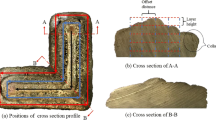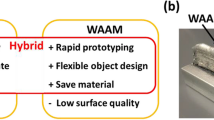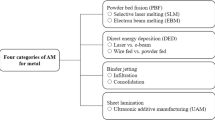Abstract
Wire and arc additive manufacturing (WAAM) based on gas metal arc welding (GMAW) is a potential technology for fabricating large-scale metallic structures due to its high deposition rate, high energy efficiency, and low cost. It can produce near net-shape components by depositing metallic material layer by layer using a welding process. This paper presents a robotic additive and subtractive manufacturing system. In manufacturing large and high thin-walled structures, a critical issue is the unevenness of the layers. The accumulation of layers with poor flatness leads to significant differences in the heights of different positions in a layer, making it unable to continue the multi-layer material depositing process. The objective of this research is to investigate optimization strategies for manufacturing large and high thin-walled metallic structures with the robotic additive and subtractive manufacturing system. Three optimization strategies are proposed to obtain flat layers, including deposition with weaving, arc igniting and arc extinguishing control, and local measuring and milling strategy. Experiments were designed to explore the effect of these strategies. The experimental results show that the combination of these strategies can improve the surface flatness of layers, reducing the differences in the heights of a layer. Using these strategies, a large and high thin-walled component is manufactured, demonstrating the potential for fabricating large metallic parts in a very short time by the robotic additive and subtractive manufacturing system. Besides, regression models were generated for establishing the relationship between process parameters and bead geometry in deposition with weaving.
Similar content being viewed by others
References
Levy GN, Schindel R, Kruth JP (2003) Rapid manufacturing and rapid tooling with layer manufacturing (lm) technologies, state of the art and future perspectives. CIRP Ann-Manuf Technol 52(2):589–609
Ding D, Pan Z, Cuiuri D, Li H (2015) A practical path planning methodology for wire and arc additive manufacturing of thin-walled structures. Robot Comput Integr Manuf 34:8–19
Karunakaran K, Suryakumar S, Pushpa V, Akula S (2010) Low cost integration of additive and subtractive processes for hybrid layered manufacturing. Robot Comput Integr Manuf 26(5):490–499
Xiong J, Zhang G (2014) Adaptive control of deposited height in GMAW-based layer additive manufacturing. J Mater Process Technol 214(4):962–968
Xiong J, Zhang G, Zhang W (2015) Forming appearance analysis in multi-layer single-pass GMAW-based additive manufacturing. Int J Adv Manuf Technol 80(9–12):1767–1776
Ding D, Pan ZS, Cuiuri D, Li H (2014) A tool-path generation strategy for wire and arc additive manufacturing. Int J Adv Manuf Technol 73(1-4):173–183
Wang F, Williams S, Rush M (2011) Morphology investigation on direct current pulsed gas tungsten arc welded additive layer manufactured ti6al4v alloy. Int J Adv Manuf Technol 57(5-8):597–603
Geng H, Xiong J, Huang D, Lin X, Li J (2017) A prediction model of layer geometrical size in wire and arc additive manufacture using response surface methodology. Int J Adv Manuf Technol 93(1–4):175–186
Martina F, Mehnen J, Williams SW, Colegrove P, Wang F (2012) Investigation of the benefits of plasma deposition for the additive layer manufacture of ti–6al–4v. J Mater Process Technol 212(6):1377–1386
Xiong X, Zhang H, Wang G (2009) Metal direct prototyping by using hybrid plasma deposition and milling. J Mater Process Technol 209(1):124–130
Mughal M, Fawad H, Mufti R (2006) Three-dimensional finite-element modelling of deformation in weld-based rapid prototyping. Proc Institut Mech Eng Part C: J Mech Eng Sci 220(6):875–885
Ding D, Shen C, Pan Z, Cuiuri D, Li H, Larkin N, et al (2016) Towards an automated robotic arc-welding-based additive manufacturing system from cad to finished part. Comput Aided Des 73:66–75
Panchagnula JS, Simhambhatla S (2018) Manufacture of complex thin-walled metallic objects using weld-deposition based additive manufacturing. Robot Comput Integr Manuf 49:194–203
Zhang Y, Chen Y, Li P, Male AT (2003) Weld deposition-based rapid prototyping: a preliminary study. J Mater Process Technol 135(2-3):347–357
Akula S, Karunakaran K (2006) Hybrid adaptive layer manufacturing: an intelligent art of direct metal rapid tooling process. Robot Comput Integr Manuf 22(2):113–123
Almeida PMS, Williams S (2010) Innovative process model of tic6alc4v additive layer manufacturing using cold metal transfer (CMT). In: Proccedings of the international solid freeform fabrication symposium, pp 25–36
Ding D, Pan Z, Cuiuri D, Li H (2015) A multi-bead overlapping model for robotic wire and arc additive manufacturing (WAAM). Robot Comput Integr Manuf 31:101–110
Li Y, Sun Y, Han Q, Zhang G, Horváth I (2018) Enhanced beads overlapping model for wire and arc additive manufacturing of multi-layer multi-bead metallic parts. J Mater Process Technol 252:838–848
Chen Y, He Y, Chen H, Zhang H, Chen S (2014) Effect of weave frequency and amplitude on temperature field in weaving welding process. Int J Adv Manuf Technol 75(5-8):803–813
Zhan X, Liu X, Wei Y, Chen J, Chen J, Liu H (2017) Microstructure and property characteristics of thick invar alloy plate joints using weave bead welding. J Mater Process Technol, 244
Xu X, Ding J, Ganguly S, Diao C, Williams S (2018) Preliminary investigation of building strategies of maraging steel bulk material using wire + arc additive manufacture. J Mater Eng Perform, 1–7
Suryakumar S, Karunakaran KP, Bernard A, Chandrasekhar U, Raghavender N, Sharma D (2011) Weld bead modeling and process optimization in hybrid layered manufacturing. Comput Aided Des 43(4):331–344
Aichholzer O, Aurenhammer F, Alberts D, Gärtner B (1996) A novel type of skeleton for polygons. In: J. UCS the journal of universal computer science. Springer, pp 752–761
Funding
This research was supported by the Beijing Municipal Project of Science and Technology (no. Z161100001516005).
Author information
Authors and Affiliations
Corresponding author
Additional information
Publisher’s Note
Springer Nature remains neutral with regard to jurisdictional claims in published maps and institutional affiliations.
Appendices
Appendix A: Robotic measuring
According to Eq. 8, when the process parameters are set, it is applicable to calculate the theoretical bead height h for a single layer. Then, for a certain layer (layer n), the theoretical height can be described as Eq. 9.
A laser displacement sensor is used to measure the height of the thin-walled structure. As shown in Fig. 22, suppose the distance between a measuring point and the bottom of the sensor is d, then calculate the measuring result Δd (obtained from the controller of the sensor) as Eq. 10
where d0 is a constant value (20 mm). As shown in Fig. 23, before the deposition of the first layer, the laser displacement sensor is placed above the baseplate. When the measuring result is zero, the distance between the baseplate and the bottom of the sensor is d0, and we obtain the Z value of the measuring tool point of the robot, z0. After depositing n layers, we set the Z value of the measuring tool point to be z0 + heightt(n) and move the sensor in plane above the thin wall. Then, the measuring results are the errors between the actual and theoretical heights. The actual height at a sampling point of a deposited layer, heighta, can be obtained as Eq. 11
where Δd is the measured result at a sampling point.
Appendix B: Experimental data
Tables 7 and 8 show all the width and height of experimental beads with different parameters. Serial numbers used as test data to verify predictable accuracy of the regression models are as follows. {2, 8, 15, 16, 19, 21, 22, 24, 28, 29, 31, 32, 33, 34, 36, 38, 39, 41, 43, 50, 51, 53, 65, 68, 84, 86, 87, 109, 111, 112, 113, 117, 120, 124, 125, 127, 130, 131, 145, 146, 147, 151, 152, 157, 158, 159, 161, 168}.
Rights and permissions
About this article
Cite this article
Ma, G., Zhao, G., Li, Z. et al. Optimization strategies for robotic additive and subtractive manufacturing of large and high thin-walled aluminum structures. Int J Adv Manuf Technol 101, 1275–1292 (2019). https://doi.org/10.1007/s00170-018-3009-3
Received:
Accepted:
Published:
Issue Date:
DOI: https://doi.org/10.1007/s00170-018-3009-3






